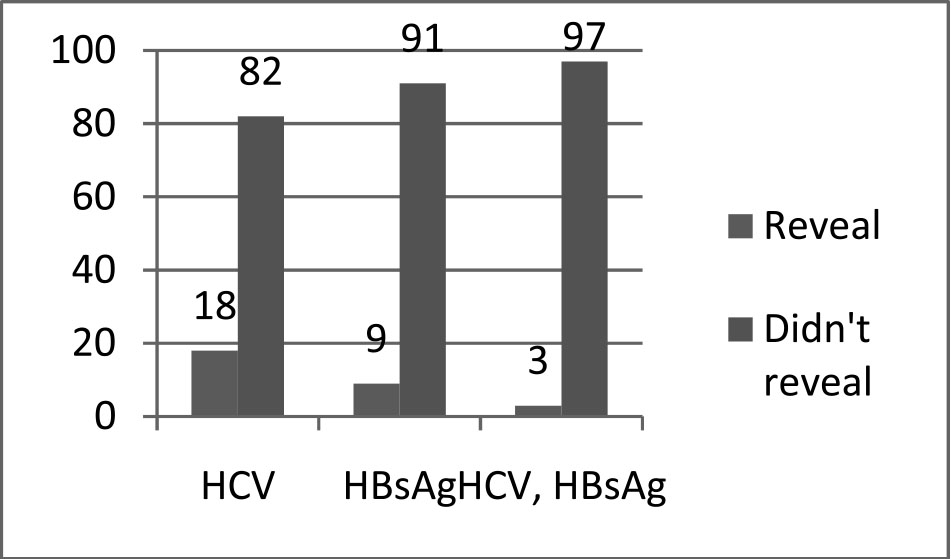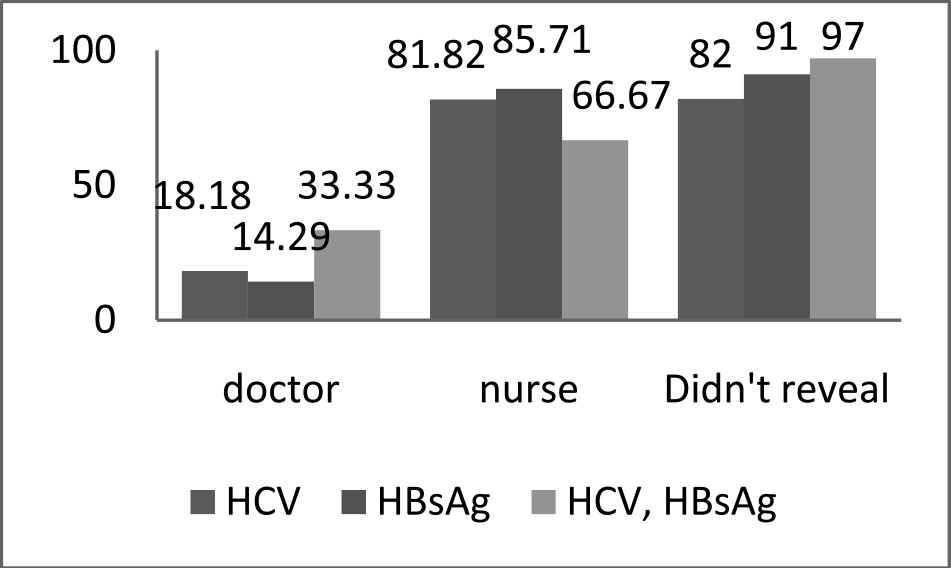Онош, 2011, 49(049)
IDENTIFICATION OF HEPATITIS В (HBV) AND C (HCV) VIRUS INFECTION AMONG DOCTORS AND NURSES IN TERTIARY HOSPITALS
( Судалгааны өгүүлэл )
Абстракт
Abstract
M.Colombo (1989), W.Lange (1992) studies showed that 30-40% of people became chronic after suffering from hepatitis B virus (HBV) and C virus (HCV) and about 50% of chronic cases transformed into primary liver cancer. There have been conducted few studies in our country were conducted on hepatitis among health professionals, particular nurses. In a study carried out by Chimedsuren (8) showed that 19.4% of people with identified surface hepatitis B antigen (HBsAg) and antibodies to hepatitis C virus and 8% of people with identified nucleotide of RNA of hepatitis C virus (polymerase chain reaction) had an acute form of hepatitis C. Studies on hepatitis virus genome damaging effect on liver cells showed that genotype 8 (A, B, C, D, E, F, G, TTV) carried the most damaging effect on a livercells (Hahn and Faeka, 2007).
Several studies showed a relationship between hepatitis B virus infection and holes in some regulations of infection control by medical personnel rendering some medical assistance. Results of a study from the Maternal and Child Health Research Centre showed that tests performed to detect hepatitis B virus antigen and antibodies to C virus did not reveal both antigen and antibodies in 69% cases, separately B virus and antibodies to hepatitis C virus were identified in 13% and 9% respectively. Results of tests taken from health personnel in Shastin Central Hospital showed that in 76% of cases B virus antigen with C virus antibodies were not identified, in 8% of cases B virus antigen was present on its own. Combination of B virus antigen and C virus antibodies were present in 8% of nurses and doctors respectively. Negative results on detection of combination of B virus antigen and C virus antibodies taken from health personnel of the State Central Clinical Hospital were in 82% cases whereas B virus antigen and C virus antibodies on their own were revealed in 7% and 14% respectively. Combined cases of B virus antigen and C virus antibodies were identified in 4% of personnel. Results of tests taken from health personnel in Hospital of Ministry of Justice and Internal Affairs showed that in 79% of cases B virus antigen with C virus antibodies were not identified, separately
В virus and antibodies to hepatitis C virus were identified in 8% and 13% respectively.
Key words: Doctor, nurse, B (HBV), C (HCV), hepatitis virus causative
INTRODUCTION
M.Colombo (1989), W.Lange (1992) studies showed that 30-40% of people became chronic after suffering from hepatitis B virus (HBV) and C virus (HCV) and about 50% of chronic cases transformed into primary liver cancer. There are few studies in our country were conducted on hepatitis among health professionals, particular nursing personnel. In study carried out by Chimedsuren (8) showed that 19.4% of people with identified surface hepatitis B antigen (HBsAg) and antibodies to hepatitis C virus and 8% of people with identified nucleotide of RNA of hepatitis C virus (polymerase chain reaction) had acute form of hepatitis C. Studies on hepatitis virus genome damaging effect on liver cells showed that genotype 8 (A, B, C, D, E, F, G, TTV) was the most common (Hahn and Faeka, 2007). Performed study and solved problem about considering determining and proving risk of doctors and medical workers affecting to hepatitis infection, if they get infection when they are rendering medical aid and service, state coordinating payment of health and treatment of doctors and nurses or decides it by additional health insurance and bringing work and labor condition close to European countries level is not sufficient. It shows that it is necessary to do this study in detail.
GOAL
To identify antigens and antibodies of hepatitis B virus (HBV) and C virus (anti-HCV) among doctors and nurses.
OBJECTIVES
To identify surface antigen (HBsAg) of hepatitis B virus (HBV) among doctors and nurses.
To identify antibody to hepatitis C virus (HCV) among doctors and nurses.
To compare exposure rate to the infection by the type of hospital and profession.
METHODS AND MATERIALS
The study was a cross-sectional study carried out among selected health professionals, doctors and nurses, to determine surface antigen of hepatitis B virus and antibodies to hepatitis C virus. For identification of these antibodies and antigen, and validation of results Serodia tests from Fujinebo Company (Japan) and Beringnost (Germany) were used respectively.
Blood samples from 100 nurses and nine doctors were collected of the State Central Clinical Hospital, Shastin's State Hospital, Hospital of Ministry of Justice and Internal Affairs, and the Maternal and Child Health Research Centre in order to identify surface antigen of hepatitis B virus and C virus antibodies. Questionnaires were used to determine knowledge, attitude and practice of personnel on hepatitis infection.
Ethical approval was obtained from the Ethical Committee of the Health Sciences University of Mongolia before the study (° 68/20). Statistical analysis was performed using SPSS 11.5 version.
RESULTS
There were 100 nurses and nine doctors from the State Central Clinical Hospital, Shastin's State Hospital, Hospital of Ministry of Justice and Internal Affairs, and the Maternal and Child Research Centre who participated in the study. More than half of participants (59%) said that they were exposed to the infection during performing medical procedures. In particular, most reported obtaining the infection through a cut or wound in the right hand.
The risk of exposure to HIV infection during performing some procedures was 0.136, 0.121, 0.125, and 0.138 in the Maternal and Child Research Centre, Shastin Central Hospital, and Hospital of Justice and Internal affairs respectively.
B virus antigen and C virus antibodies were not revealed in 43% of people. B virus antigen was identified alone in 9%, C virus antibodies were revealed alone in 45%. B virus antigen and C virus antibodies were revealed in 3% of nurses. Nurses with identified B virus antigen and C virus antibodies were 66%.
DISCUSSION
Several researchers noted that health personnel are exposed to hepatitis infections performing procedures. This is especially they follow the rules provided by their infection control board (22.27). Risk of getting infection for medical personnel was 95% performing therapeutic and nursing procedures and only 5% during immunization. (3).
There is an urgent need to provide knowledge to medical personnel regarding standards during procedures, concerning hepatitis infections, their monitoring and improve technology used during procedures.
Figure 1. Proportion of nurses and doctors of 4 hospitals of the city with HCV and HBsAg

Figure 2. Proportion of nurses and doctors of 4 hospitals of the city with HCV and HBsAg, by profession

More than half of the medical personnel studied (59%) were identified with hepatitis B virus antigen and hepatitis C virus antibodies. Knowledge, attitude and practice on risks of getting infection were not sufficient.
REFERENCES
Alimaa.D, Mart.G, Shijirbaatar.B, Lhagvajav.B, Shijirbaatar.CH, Badamjab.G, (1996) «Chronic hepatitis propagation among the population of rural areas», »Academic Assembly of teachers, of Health Sciences University» (38) U.B. p-192-193
Alimaa.D, Orgodolbat.A, ShijirbaatarA, Khaltar. TS. Altantsetseg.J, Khadbaatar.U, Purevsuren.U (1996) «Defining hepatitis marker and some biological indices among non medical workers of Central aimag hospital* «Academic Assembly of teachers, of Health Sciences University* (38) U.B. р-194-195»
Badamsed.TS, Tserendash.B, (2003 °4(126) »Differential diagnosing of focal change of liver by ultrasound diagnosing method». Mongolian medicine. UB. p-14-20
Bayarsaikhan.B, (1997) «Nowadays condition of liver cirrhosis, in order to prevent from hemorrhage to fill spleen artery» Masters work. UB, p-39
Bold.M (1998) «Some peculiarity of liver cirrhosis structure and complication*. Masters work of medicine. UB, p-36
Ganbaatar.B, Chimedsuren.O (2000.°2) «Study review of defining hepatitis B, C virus propagation by zero epidemiological method* «Onosh» journal, U.B. p-10-1
Gantsetseg.UA, Zulkhuu.G (1999) «To some problem of cause of chronic hepatitis and clinics», U.B.p-46-47
Gombosuren.T, (1969) «Some problems of epidemiology and prophylactics of infections hepatitis* Autoref. Kand.Diss.U.B.
Darmaa.B, Ganbaatar.B, Hahh.H,
Myagmarsuren.SH, (2004) «Defining reveal of hepatitis B virus antigen and C virus antibody among medical workers* Academic Assembly of teachers, of Health Sciences University
Dorjdagva.D, (1998) «Reveal of B, C virus on people with chronic inflammation (hepatitis) of Altai city* Masters work of medicine. UB, p-49
Gabriella De Carly «Transmission of blood-borne viruses in the health-care setting: from patient, to patient, from patient, to health-care worker, and from health-care worker to patient* 26th hepatitis B, hepatitis C, and other blood-borne infections in health-care workers. Viral hepatitis prevention board meeting Rome, Italy, March17-18,2005 Available at: http: //www.cdc.gov/niosh/
Lan. O. Willams, PhD.MS «Health-саге related outbreaks of Hepatitis B and C in the United status* Viral hepatitis prevention board meeting Rome 33, Available at: http: //www.cdc.gov/niosh/
Нийтлэлийн нээгдсэн тоо: 1063




